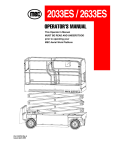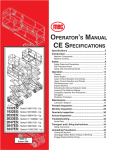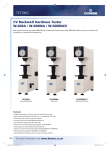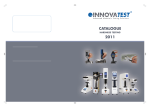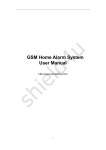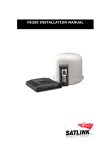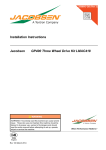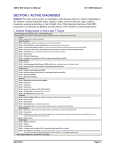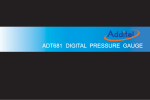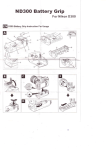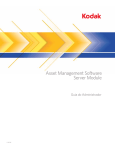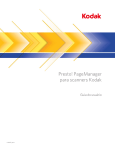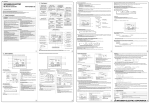Download 91831
Transcript
ART_2849 2591ES | 3391ES | 4191ES Scissor Lift 2591ES Serial #11400001 – up 3391ES Serial #11500001 – up 4191ES Serial #11600001 – up 91831 December 2008 Introduction. . . . . . . . . . . . . . . . . . . . . . . . . . . . . . . . . . . . . . . . . . . 1 Safety. . . . . . . . . . . . . . . . . . . . . . . . . . . . . . . . . . . . . . . . . . . . . . . . . 2 Safety Alert Symbols . . . . . . . . . . . . . . . . . . . . . . . . . . . . . . . . . . . . 3 Fall Protection . . . . . . . . . . . . . . . . . . . . . . . . . . . . . . . . . . . . . . . . . . 4 Electrocution Hazard . . . . . . . . . . . . . . . . . . . . . . . . . . . . . . . . . . . 5 Tip-over Hazards. . . . . . . . . . . . . . . . . . . . . . . . . . . . . . . . . . . . . . . . 6 Fall Hazards . . . . . . . . . . . . . . . . . . . . . . . . . . . . . . . . . . . . . . . . . . . . 7 Collision Hazards . . . . . . . . . . . . . . . . . . . . . . . . . . . . . . . . . . . . . . . 7 Additional Safety Hazards. . . . . . . . . . . . . . . . . . . . . . . . . . . . . . . 8 Battery Safety . . . . . . . . . . . . . . . . . . . . . . . . . . . . . . . . . . . . . . . . . . 8 Jobsite Inspection . . . . . . . . . . . . . . . . . . . . . . . . . . . . . . . . . . . . . . 9 Function Tests . . . . . . . . . . . . . . . . . . . . . . . . . . . . . . . . . . . . . . . . . . 9 Operating Instructions . . . . . . . . . . . . . . . . . . . . . . . . . . . . . . . . 10 Prestart. . . . . . . . . . . . . . . . . . . . . . . . . . . . . . . . . . . . . . . . . . . . . . . . 10 Base Controls Operation and Test . . . . . . . . . . . . . . . . . . . . . . 11 Platform Control Operation and Test . . . . . . . . . . . . . . . . . . . 12 Joystick Operation . . . . . . . . . . . . . . . . . . . . . . . . . . . . . . . . . . . . . 12 Outrigger Operation (optional). . . . . . . . . . . . . . . . . . . . . . . . . 15 Shutdown Procedure . . . . . . . . . . . . . . . . . . . . . . . . . . . . . . . . . . 15 Emergency Systems. . . . . . . . . . . . . . . . . . . . . . . . . . . . . . . . . . . 16 Emergency Lowering – 2591ES – 3391ES . . . . . . . . . . . . . . . 16 Emergency Lowering – 4191ES. . . . . . . . . . . . . . . . . . . . . . . . . 16 Deck Extension . . . . . . . . . . . . . . . . . . . . . . . . . . . . . . . . . . . . . . . 17 Fold Down Platform Railings . . . . . . . . . . . . . . . . . . . . . . . . . . 18 Machine Inspections and Maintenance . . . . . . . . . . . . . . . . . 20 Pre-Start Inspection Checklist . . . . . . . . . . . . . . . . . . . . . . . . . . 21 Monthly Inspection Checklist . . . . . . . . . . . . . . . . . . . . . . . . . . 22 Quarterly Inspection Checklist . . . . . . . . . . . . . . . . . . . . . . . . . 23 Maintenance . . . . . . . . . . . . . . . . . . . . . . . . . . . . . . . . . . . . . . . . . 25 Routine Maintenance . . . . . . . . . . . . . . . . . . . . . . . . . . . . . . . . . . 26 Scheduled Maintenance . . . . . . . . . . . . . . . . . . . . . . . . . . . . . . . 26 Maintenance Lock . . . . . . . . . . . . . . . . . . . . . . . . . . . . . . . . . . . . . 26 Lubrication . . . . . . . . . . . . . . . . . . . . . . . . . . . . . . . . . . . . . . . . . . . . 27 Battery Charger . . . . . . . . . . . . . . . . . . . . . . . . . . . . . . . . . . . . . . 28 Component Locations. . . . . . . . . . . . . . . . . . . . . . . . . . . . . . . . . 30 Warning and Instructional Decals . . . . . . . . . . . . . . . . . . . . . . 34 Troubleshooting. . . . . . . . . . . . . . . . . . . . . . . . . . . . . . . . . . . . . . 36 Transport and Lifting Instructions. . . . . . . . . . . . . . . . . . . . . . 38 Loading . . . . . . . . . . . . . . . . . . . . . . . . . . . . . . . . . . . . . . . . . . . . . . . 38 Lifting and Tie Down Instructions . . . . . . . . . . . . . . . . . . . . . . 40 —Specifications— 2591ES Working Height* Platform Height Platform Entry Height Rails Up Stowed Height Rails Folded Down 3391ES 9.62 m* 39 FT* 12.06 m* 47 FT* 14.50 m* 25 FT 7.62 m 33 FT 10.06 m 41 FT 12.50 m 57 IN 1.45 m 66 IN 1.67 m 74 IN 1.88 m 100.5 IN 2.55 m 109.5 IN 2.78 m 119 IN 3.02 m 71 IN 1.80 m 79 IN 87.5 IN 2.22 m 2.01 m Maximum Number of Occupants 5 5 4 Lift Capacity (Evenly Distributed) 2000 LB 907 kg 1500 LB 500 LB 227 kg 500 LB With Roll-Out Deck Extended 180 IN 4.57 m With Roll-Out Deck Retracted 132 IN 3.35 m Roll-out Deck Capacity 4191ES 31 FT* 4 4 4 1000 LB 454 kg 227 kg 500 LB 227 kg 180 IN 4.57 m 180 IN 4.57 m 132 IN 3.35 m 132 IN 3.35 m 680 kg Platform Dimensions 71 IN 1.80 m 71 IN 1.80 m 71 IN 1.80 m Guardrail Height 44.5 IN 1.13 m 44.5 IN 1.13 m 44.5 IN 1,13 m Toeboard Height 7.0 IN 18 cm 7.0 IN 18 cm 7.0 IN 18 cm Roll-out Deck Length 48 IN 1.22 m 48 IN 1.22 m 48 IN 1.22 m 144 IN 3.66 m 144 IN 3.66 m 144 IN 3.66 m 4.57 m 180 IN 4.57 m 180 IN 4.57 m Deck Width (inside) Overall Length With Outriggers 180 IN 91 IN 2.31 m 91 IN 2.31 m 91 IN 2.31 m Wheel Base 102.5 IN 2.60 m 102.5 IN 2.60 m 102.5 IN 2.60 m Wheel Track 78.5 IN 1.99 m 78.5 IN 1.99 m 78.5 IN 1.99 m Overall Width Turning Radius Inside 76 IN 1.93 m 76 IN 1.93 m 76 IN 1.93 m Outside 195 IN 4.95 m 195 IN 4.95 m 195 IN 4.95 m 12.0 IN 30.48 cm 12.0 IN 30.48 cm 12.0 IN 30.48 cm Ground Clearance Machine Weight** (Unloaded) (Approx.) Ground Pressure/Wheel (Maximum) 8,600 LB** 3901 kg** 9,300 LB** 4218 kg** 10,300 LB** 4672 kg** 118 PSI 8.29 kg/cm² 120 PSI 8.43 kg/cm² 125 PSI 8.79 kg/cm² 3687 LB Wheel Load 1672 kg 24 sec / 28 sec Lift/Lower Speed (Approx.) 3747 LB 1699 kg 35 sec / 40 sec Drive Speed (Platform Elevated) 0 – 0.5 MPH 0 –0.8 km/h Drive Speed (Platform Lowered) 0 – 2.6 MPH 0 – 4.2 km/hr 45% / 24.2° Gradeability 80 PSI 5.5 bar Foam-Filled Foam-Filled 150-165 FT/LB 204-225 Nm Main System 3000 PSI 207 bar Lift System 2500 PSI 172 bar Steer 2000 PSI 103 bar 23 GAL 87 liters Tire Pressure, 12 Ply Pneumatic 12 Ply Foam-Filled (Option) Wheel Lug Nut Torque Hydraulic Fluid Capacity 48 Volts DC Power System – Voltage Eight 6 Volt DC 350 amp hour industrial, deep cycle Battery Pack Battery Charger 45% / 24.2° 12-16.5 NHS “Outrigger” Tire Size-Standard Input 120 Volt AC, 50.60 Hz, 18 Amp—240 Volt AC, 50.60 Hz, 9 Amp Output Electric Motor Brakes Meets requirements of ANSI A92.6-2006 Section 4. *Working height adds 6 feet (2 m) to platform height. **Weight may increase with certain options or country standards. 48 Volt DC, 32 Amp, 1500 W, Timed Shutoff 8 h.p. (6 kW): 3600 rpm Multi disc / Dual Rear Wheel 1768 kg 45 sec / 52 sec 2 Wheel Drive Standard, 4 Wheel Drive Option Drive System (Proportional) Hydraulic Pressure 3897 LB 2591ES | 3391ES | 4191ES Introduction Introduction This Operator’s Manual has been designed to provide you, the customer, with the instructions and operating procedures essential to properly and safely operate your MEC Aerial Work Platform for its intended purpose of positioning personnel, along with their necessary tools and materials, to overhead work locations. The Operator’s Manual must be read and understood prior to operating your MEC Aerial Work Platform. The user/operator should not accept operating responsibility until he/she has read and understands the operator’s manual as well as having operated the MEC Aerial Work Platform under supervision of an authorized, trained and qualified operator. It is essential that the operator of the aerial work platform is not alone on the workplace during operation. Modifications of this machine from the original design and specifications without written permission from MEC are strictly forbidden. A modification may compromise the safety of the machine, subjecting operator(s) to serious injury or death. Your MEC Aerial Work Platform has been designed, built, and tested to provide safe, dependable service. Only authorized, trained and qualified personnel should be allowed to operate or service the machine. MEC, as manufacturer, has no direct control over machine application and operation. Proper safety practices are the responsibility of the user and all operating personnel. If there is a question on application and/or operation contact: MEC Aerial Platform Sales Corp. 1775 Park Street, Suite 77 Selma, CA 93662 USA Phone: 1-800-387-4575 559-891-2488 Fax: 559-891-2448 www.mecawp.com 91831 – December 2008 Page 1 2591ES | 3391ES | 4191ES Safety Safety DO NOT operate this machine until you have read and understood the Safety section of this manual, have performed the Jobsite Inspection, Pre-Start Inspection and Routine Maintenance, and have completed all the test operations detailed in the Operating Instructions section. Failure to read, understand and follow all safety rules, warnings, and instructions will unnecessarily expose you and others to dangerous situations. For your safety and the safety of those around you, you must operate your machine as instructed in this manual. MEC designs aerial work platforms to be safe and reliable. They are intended to position personnel, along with their necessary tools and materials, to overhead work locations. The owner/user/operator of the machine should not accept responsibility for the operation of the machine unless properly trained. ANSI and other applicable standards identify requirements of all parties who may be involved with self-propelled elevating work platforms. The ANSI/SIA A92.56-2006 Manual of Responsibilities is considered a part of this machine and can be found in the manual compartment, located at the platform control station. To ensure safe use of machine, inspections specified in ANSI/SIA A92.6-2006 Section 6.7 must be performed at designated intervals as prescribed. Never perform service on the machine with the platform elevated without first blocking the scissor assembly using the maintenance lock (see Maintenance Lock on page 26). California Proposition 65 Warning This product contains chemicals known to the State of California to cause cancer and/or birth defects or other reproductive harm. Page 2 91831 – December 2008 2591ES | 3391ES | 4191ES Safety Safety Alert Symbols MEC manuals and decals use symbols and colors to help you recognize important safety, operation and maintenance information. RED – Indicates an imminently hazardous situation which, if not avoided, will result in death or serious injury. ORANGE – Indicates a potentially hazardous situation which, if not avoided, could result in death or serious injury. YELLOW with alert symbol – Indicates a potentially hazardous situation which, if not avoided, may result in minor or moderate injury. YELLOW without alert symbol – Indicates a potentially hazardous situation which, if not avoided, may result in property damage. 91831 – December 2008 Page 3 2591ES | 3391ES | 4191ES Safety Fall Protection Operators must comply with employer, job site and governmental rules regarding the use of personal protective equipment. If required by your employer or job site, use personal fall protection equipment (PFPE) when operating this machine. All PFPE must comply with applicable governmental regulations, and must be inspected and used in accordance with the PFPE manufacturer’s instructions. Fall restraint must be properly attached to a designated anchorage point when driving or operating the machine. Attach only one fall restraint to each anchorage point. Lanyard Anchorage Points Art_2836 1 9072 181 273 33 kg kg 454 91730 kg kg 261 400N kg kg 487 181 273 kg kg 91385 454 33 kg kg 181 214 400N kg kg ART_2763 R1 Page 4 91831 – December 2008 2591ES | 3391ES | 4191ES Safety Electrocution Hazard ELECTROCUTION HAZARD!!! THIS MACHINE IS NOT INSULATED! DEATH OR SERIOUS INJURY will result from contact with or inadequate clearance from any electrically charged conductor. You must maintain a CLEARANCE OF AT LEAST 10 FEET (3.05 m) between any part of the machine, or its load, and any electrical line or apparatus carrying over 300 Volts up to 50,000 Volts. One foot (30.5 cm) additional clearance is required for every additional 30,000 Volts. Observe Minimum Safe Approach Distance. DO NOT work in close proximity to, or in contact with, energized power lines and electrical equipment. This machine is not insulated and WILL NOT protect the operator from injury or the machine from damage. Refer to Table and all applicable governmental regulations for the minimum safe distances from energized power lines and electrical equipment. Minimum Save Approach Distance Art_2824 Voltage Minimum Safe Approach Distance Phase to Phase Feet Meters 0 to 300 Volts Avoid Contact Over 300V to 50kv 10 3.05 Over 50KV to 200KV 15 4.60 Over 200KV to 350KV 20 6.10 Over 350KV to 500KV 25 7.62 Over 500KV to 750KV 35 10.67 Over 750KV to 1000KV 45 13.72 Art_2823 DO NOT touch the machine if it contacts energized power lines. Personnel in the platform: • Move away from the platform rails, • DO NOT attempt to operate the machine, and • DO NOT touch any part of the machine until energized power lines are shut off. Personnel on the ground: • DO NOT approach the machine and • DO NOT touch or attempt to operate the machine until energized power lines are turned off. Do not operate the machine during electrical storms or lightning. DO NOT use the machine as a ground for welding unless properly equipped with a weld line to platform option. 91831 – December 2008 Page 5 2591ES | 3391ES | 4191ES Safety Tip-over Hazards DO NOT exceed the maximum platform capacity (see Specifications). The weight of options and accessories will reduce the rated platform capacity and must be factored into the total platform load. Refer to the decals on the options. DO NOT elevate the platform when the machine is on a surface that is soft and / or on a slope. If the alarm sounds when the platform is raised, use extreme caution to lower the platform. Art_2828 DO NOT OVERLOAD Driving: DO NOT drive the machine on a slope that exceeds the maximum uphill, downhill or side slope rating. Slope rating applies to machines in the stowed position. Slope rating is subject to ground and traction conditions. Driving in stowed position: use extreme care and slow speeds when driving across uneven terrain, debris, unstable or slippery surfaces, and near holes or drop-offs. Driving with the platform elevated: DO NOT drive on or near uneven terrain, unstable surfaces or other hazardous conditions. DO NOT push off or pull toward any object outside the platform. Art_2834 DO NOT DRIVE ON IRREGULAR OR UNSTABLE SURFACE Maximum Allowable Side Force ANSI and CSA 150 lbs (667 N) CE and AUS 90 lbs (400 N) DO NOT elevate the platform when wind speeds are in excess of 28 m.p.h. (12.5 m/s). If these wind speeds occur when the platform is elevated, carefully lower and discontinue operation. DO NOT increase the surface area of the platform (i.e. cover the rails with tarp or plywood). Increased surface area exposed to the wind will decrease machine stability. DO NOT attach overhanging loads or use the machine as a crane. Art_2833 DO NOT PUSH OR PULL OBJECTSOUTSIDE PLATFORM DO NOT transport tools and materials unless they are evenly distributed and can be safely handled by personnel in the platform. Secure all tools and loose materials to prevent injury to personnel below the platform. DO NOT alter or disable machine components that may affect safety and stability. DO NOT replace items critical to machine stability with items of different weight or specification. DO NOT modify or alter the work platform without written permission from MEC, as modifications can increase weight and/or surface area resulting in instability. DO NOT place ladders or scaffolds in the platform or against any part of the machine. DO NOT use the machine on a moving or mobile surface or vehicle. Art_2831 DO NOT ELEVATE IN WINDY CONDITIONS Ensure that all tires are in good condition, air filled tires are properly inflated and lug nuts are properly torqued. Art_2832 DO NOT USE AS CRANE Page 6 91831 – December 2008 2591ES | 3391ES | 4191ES Safety Fall Hazards DO NOT sit, stand or climb on the platform guard rails. Maintain a firm footing on the platform floor at all times. DO NOT exit the platform when elevated DO NOT climb down from the platform when elevated. Keep the platform floor clear of debris. Art_2826 DO NOT CLIMB ON RAILS DO NOT fasten a fall restraint lanyard to an adjacent structure. Ensure that the entry is properly closed before operating the machine. Operators must comply with employer, job site and governmental rules regarding the use of personal protective equipment. Art_2825 DO NOT EXIT PLATFORM WHEN ELEVATED Collision Hazards Be aware of blind spots while operating this machine. Watch for overhead obstructions when elevating the platform. Watch for crushing hazards when holding the platform rail. Reduce travel speed when moving the machine on slopes, when near personnel and obstacles, or when surface conditions are wet, slippery or otherwise limiting. Art_2835 DO NOT operate in the path of any crane unless the controls of the crane have been locked out and/or precautions have been taken to prevent any possible collision. Stunt driving and horseplay are PROHIBITTED. Art_2829 Art_2827 91831 – December 2008 Page 7 2591ES | 3391ES | 4191ES Safety Additional Safety Hazards Explosion and Fire Hazards DO NOT operate the machine in hazardous locations or locations where potentially flammable or explosive gasses or particles may be present. Damaged Machine Hazards Conduct a thorough pre-start inspection of the machine and test all functions before each work shift to check for damage, malfunction and unauthorized modification. Tag and remove a damaged, malfunctioning or modified machine from service. DO NOT use a damaged, malfunctioning or modified machine. Routine maintenance must be performed by the operator before each work shift. Scheduled maintenance must be performed by a qualified service technician at scheduled intervals. Tag and remove from service any machine that has not had scheduled preventative maintenance performed. Check that all safety and instructional decals are in place and undamaged. Check that the operator’s, safety and responsibilities manuals are present in the storage container located in the platform. All manuals must be complete, undamaged and readable. Bodily Injury Hazards DO NOT operate the machine when there is a hydraulic fluid or air leak. Hydraulic fluid or air under pressure can penetrate and/or burn skin. All compartments must remain closed and secure during machine operation. Improper contact with components under any cover will cause serious injury. Only trained maintenance personnel should access compartments. The operator should only access a compartment when performing pre-operation inspection. Weld Line to Platform Safety (if equipped) Read, understand and follow all warnings and instructions provided with the welding power unit. Do not connect weld leads or cables unless the welding power unit is turned off at the platform controls. DO NOT operate unless the weld cables are properly connected. Battery Safety Burn Hazards Batteries contain acid. Always wear protective clothing and eye wear when working with batteries. Avoid spilling or contacting battery acid. Neutralize battery acid spills with baking soda and water. Explosion Hazard Keep sparks, flame and lighted tobacco away from batteries. Batteries emit explosive gas. Electrocution Hazard Avoid contact with electrical terminals. Page 8 91831 – December 2008 2591ES | 3391ES | 4191ES Safety Jobsite Inspection DO NOT operate this machine until you have read and understood the Safety section of this manual, have performed the Jobsite Inspection, Pre-Start Inspection and Routine Maintenance, and have completed all the test operations detailed in the Operating Instructions section. Inspect the jobsite and determine whether the jobsite is suitable for safe machine operation. Do this before moving the machine to the jobsite. Be aware of changing jobsite conditions, and continue to watch for hazards while operating the machine. Workplace Inspection Check the jobsite where the machine will be used for all possible hazards, including but not limited to: • drop-offs or holes, including those concealed by water, ice, mud, etc. • sloped, unstable or slippery surfaces • bumps, surface obstructions and debris • overhead obstructions and electrical conductors • hazardous locations and atmospheres • inadequate surface and support to withstand all load forces imposed by the machine • wind and weather conditions • the presence of unauthorized personnel • other possible unsafe conditions Function Tests DO NOT operate this machine until you have read and understood the Safety section of this manual, have performed the Pre-Start Inspection, Routine Maintenance, and Functions Test, have inspected the jobsite for hazards, and have learned the operating procedures for this machine. The operator must conduct a Functions Test of the machine before each work shift to check that all machine systems are working properly. Test the machine on a firm level surface with no debris, drop-offs, potholes or overhead obstructions. Perform each step outlined in Operating Instructions on page 10. DO NOT use a machine that is malfunctioning. If any function does not perform as described, tag the machine and remove for repair by a qualified service technician. After repairs are completed, a Pre-Start Inspection and Functions Test must be performed before using the machine. 91831 – December 2008 Page 9 2591ES | 3391ES | 4191ES Operating Instructions Operating Instructions DO NOT operate this machine until you have read and understood the Safety section of this manual, have performed the Jobsite Inspection, Pre-Start Inspection and Routine Maintenance, and have completed all the test operations detailed in the Operating Instructions section. This section provides instructions for each function of machine operation. Follow all safety rules and instructions. This machine may be operated by trained and authorized personnel only. If multiple operators use this machine, all must be qualified and authorized to use it. New operators must perform a Pre-Start Inspection and Functions Test prior to operating the machine. Operators must comply with employer, job site and governmental rules regarding the use of personal protective equipment – see Fall Protection on page 4. Prestart • Perform Prestart Inspection (see page 21). • Check base control Emergency Stop Switch – turn clockwise to reset. ART_2506 R1 • Check platform control Emergency Stop Switch – turn clockwise to reset. ART_2507 R1 • Check Battery Disconnect Switch in Control Module next to Base Controls. Must be in ON position. ART_2356 • Check Charge Indicator on Base Control Panel. Battery pack should be fully charged. Note: If machine fails to operate, check the Diagnostic LED on the motor control processor inside the Control Module – see Component Locations on page 30. ART_2755 R1 Page 10 91831 – December 2008 2591ES | 3391ES | 4191ES Operating Instructions Base Controls Operation and Test IMPORTANT—Be sure the area above the machine is clear of obstructions to allow full elevation of platform. Select BASE Operation M FOR PLAT • Turn the Selector Key Switch to BASE. OFF E BAS ART_2357 R1 Emergency Stop • Press the Emergency Stop Switch at any time to stop all machine functions. • Turn switch clockwise to reset. ART_2506 R1 Do not elevate the platform if the machine is not on a firm level surface. Elevate Platform • Press and hold the RAISE button on the base control panel to elevate the platform. Test Operation • Elevate to maximum height. • Releasing the button will stop elevation. E RAIS • Pressing the Emergency Stop Switch will stop elevation. Lower Platform ER LOW ART_2358 R1 • Press the LOWER button on the base control panel until the desired platform height is reached. Test Operation • Lower the platform to the stowed position. • Releasing the button will stop descent. • Pressing the Emergency Stop Switch will stop descent. 91831 – December 2008 Page 11 2591ES | 3391ES | 4191ES Operating Instructions Platform Control Operation and Test IMPORTANT—Check that the route of travel to be taken is clear of persons, obstructions, debris, holes, and drop offs, and is capable of supporting the machine. Select PLATFORM Operation • • • • Turn the Selector Key Switch to PLATFORM. Enter the platform and secure the entry. Turn the Platform Key Switch to the ON position. Press the horn button t verify proper operation (optional). ART_2360 R1 Emergency Stop • Press the Emergency Stop Switch at any time to stop all machine functions. • Turn switch clockwise to reset. ART_2507 R1 Activation of the Emergency Stop Switch will apply brakes immediately. This may cause unexpected platform movement as the machine comes to a sudden stop. Brace yourself and secure objects on the platform during operation of machine. Joystick Operation Steer • Function speed is proportional and is controlled by the movement of the Joystick. • The further it is moved forward, the faster the speed will be. • The Joystick returns to the neutral (center) position when released. Proportional Joystick Forwa rd Lower Revers e Lift Do not elevate platform unless guardrails are installed and secure – see Fold Down Platform Railings on page 18. If the deck is extended, check for clearance beneath the deck before lowering. If the platform fails to lower DO NOT attempt to climb down the scissor assembly. Serious injury may result – see Emergency Systems on page 16. Enable Bar ART_2363 Page 12 91831 – December 2008 2591ES | 3391ES | 4191ES Operating Instructions Elevate Platform • Place the Enable Bar in the LIFT position. • Squeeze the Enable Bar and move the Joystick toward you. ART_2386 R1 Test Operation • Rate of lift is proportional and is dependent on the movement of the Joystick. • Elevate to maximum height. • Releasing the Enable Bar or the Joystick will stop elevation. • Pressing the Emergency Stop Switch will stop elevation. Lower Platform • Place the Mode Select Switch in the LIFT position. • Move the Joystick away from you. Test Operation • Rate of descent is fixed - platform lowers at same rate regardless of handle position. ART_2386 R1 • Pressing the Emergency Stop Switch will stop descent. Steer Check that the route is clear of persons, obstructions, debris, holes and drop -offs, and is capable if supporting the machine. • Always check front steer wheel direction before driving. • With the Mode Select Switch in the DRIVE position, press the Steering Switch with your thumb to steer left or right. Test Operation • Releasing the Steering Switch will stop steering function. • The steer wheels will not center themselves after a turn. • They must be returned to the straight-ahead position with the Steering Switch. Drive Torque (Speed Control) ART_2388 R1 91831 – December 2008 Drive speed is selectable until the platform is elevated above 10 Feet (3 m). When the platform is elevated the machine defaults to MID RANGE and the switch is locked-out (non functioning). • HIGH SPEED: allows speeds up to 3.0 m.p.h. (4.8 km/h). • MID RANGE: allows speeds up to 1.0 m.p.h. (1.6 km/h). • HIGH TORQUE: use to drive up or down a slope that is too steep for normal speed. Page 13 2591ES | 3391ES | 4191ES Operating Instructions Drive Forward • Place the Mode Select Switch in the DRIVE position. • Squeeze the Enable Bar and move the Joystick away from you. Test Operation ART_2362 R1 • Drive speed is proportional and is dependent on the movement of the Joystick. • Releasing the Enable Bar or returning the Joystick to the center position will stop drive. • Pressing the Emergency Stop Switch will stop drive. Drive Reverse • Place the Mode Select Switch in the DRIVE position. • Squeeze the Enable Bar and move the Joystick toward you. Test Operation ART_2362 R1 • Drive speed is proportional and is dependent on the movement of the Joystick. • Releasing the Enable Bar or returning the Joystick to the center position will stop drive. • Pressing the Emergency Stop Switch will stop drive. Brake • For parking, the brake is automatically applied when the Joystick is positioned in the neutral (center) position. Page 14 91831 – December 2008 2591ES | 3391ES | 4191ES Operating Instructions Outrigger Operation (optional) Only lower the outriggers when the machine is on a firm, level surface. The surface must be capable of supporting the maximum ground pressure per wheel/outrigger (see specifications). The Outrigger Control Switch is located on the front face of the Upper Control Box. Extend Push down and hold the Outrigger Control Switch to the EXTEND position. • The outriggers will extend and level the machine. When the machine is level and ready to operate, the outriggers will stop automatically. ART_2370 • The Indicator Lamp will turn OFF, indicating that outriggers are down and machine drive function is disabled. Retract E DRIV D BLE ENA T RAC RET Push up and hold the Outrigger Control Switch to the RETRACT position. TIC OMA S AUT IGGER END R EXT OUT IN ITCH N D SW CTIO HOL D DIRE IRE DES • The outriggers will retract. 9 9134 ART_2371 • The Indicator Lamp will turn ON, indicating that the outriggers are up and machine drive function is enabled. Shutdown Procedure • When finished with the machine, place the platform in the stowed position. • Park the machine on a level surface. • Turn the Selector Key Switch to the OFF position and remove the key to prevent unauthorized use. • Carefully exit the platform using a constant three (3) point dismount/grip. • Turn the Battery Disconnect Switch to the OFF position. Leaving the Battery Disconnect Switch in the ON position for an extended time will drain the battery. • Always put the switch in OFF position when leaving the machine at the end of the work day. • Put a padlock on the Battery Disconnect Switch to prevent unauthorized operation. Note: ART_2387 91831 – December 2008 Page 15 2591ES | 3391ES | 4191ES Emergency Systems Emergency Systems If the control system fails while the platform is elevated, have an experienced operator use the emergency lowering procedure to safely lower the platform. Do not attempt to climb down beams (scissors) assembly. Emergency Lowering – 2591ES – 3391ES The Emergency Lowering System is used to lower the platform in case of power or valve failure. To lower the platform, pull the red “T” handle located at the rear of the machine. Lowering stops when you release the “T” handle. ART_3055 91083 Emergency Lowering – 4191ES The Emergency Lowering System is used to lower the platform in case of power or valve failure. To lower the platform, perform the following steps: • Push and hold the toggle switch down to lower the platform. • Once the platform is fully lowered, release the toggle switch to close the valve. 51 Emergency Lowering Switch ART_3056 Page 16 91831 – December 2008 2591ES | 3391ES | 4191ES Deck Extension Deck Extension The deck will extend in intervals of 8 inches (20 cm) throughout the entire length of the deck extension. There are two (2) handles that hang from the top rail at the end of the deck extension Both handles are used to push or pull the deck extension to the desired position. The right-side handle is attached by cable to a spring-loaded pin at the deck. • Lift the right-side handle to raise the spring loaded pin from the locked position. • With right-side handle raised, lift the left-side handle and push to extend or pull to retract the deck. • Lower the right-side handle enough for the spring-loaded pin to engage and continue to push or pull until the pin locks into position. ART_2764 91831 – December 2008 Page 17 2591ES | 3391ES | 4191ES Fold Down Platform Railings Fold Down Platform Railings 1 ART_2837 Remove the safety snap pins holding the front extension rail to the corner post. 2 3 ART_2838 Swing the front extension rail back, next to the right side extension rail and secure with a safety snap pin. ART_2839 Remove the safety snap pin from the rear right side extension rail corner post. Lift the rail, pivot, and place on the platform floor. Page 18 continued… 91831 – December 2008 2591ES | 3391ES | 4191ES Fold Down Platform Railings Fold Down Rails (continued) 4 5 ART_2840 Remove the safety snap pin from rear left side extension rail corner post. Lift the rail, pivot and place on top of the right side extension rail. ART_2841 Remove the safety snap pins holding the entry railing to the corner posts. 6 Lift the entry rail, pivot, and place on the platform floor. 7 ART_2842 Lift the right side rail, pivot, and place on top of the entry rail. ART_2843 To return the machine to normal operation mode, lift all rails into their upright position, install all safety snap pins, and position the platform control box on the extension rail. Lift the left side rail, pivot, and place on top of the right side rail. 91831 – December 2008 Page 19 2591ES | 3391ES | 4191ES Machine Inspections and Maintenance Machine Inspections and Maintenance DO NOT operate this machine until you have read and understood the Safety section of this manual, have performed the Jobsite Inspection, Pre-Start Inspection and Routine Maintenance, and have completed all the test operations detailed in the Operating Instructions section. The operator must conduct a thorough Pre-Start Inspection of the machine and test all functions before each work shift to check for damage, malfunction and unauthorized modification. Tag and remove a damaged, malfunctioning or modified machine from service. DO NOT use a damaged, malfunctioning or modified machine. Use the Pre-Start Inspection to determine what Routine Maintenance is required. The operator may perform only the routine maintenance items specified in this manual. IMPORTANT— Scheduled maintenance inspection checklists are included in this manual for use only by qualified service technicians. Only qualified service technicians may perform repairs to the machine. After repairs are completed, the operator must perform a Pre-Start Inspection before proceeding to the Functions Test. Always use the maintenance lock to block the scissor assembly in place before servicing the machine with the platform elevated. Hydraulic fluid under pressure can penetrate and burn skin, damage eyes, and may cause serious injury, blindness, and death. Repair leaks immediately. Fluid leaks under pressure may not always be visible. Check for pin hole leaks with a piece of cardboard, not your hand. Perform scheduled maintenance at recommended intervals. Failure to perform scheduled maintenance at recommended intervals may result in a defective or malfunctioning machine and may result in injury or death of the operator. Keep maintenance records current and accurate. Immediately report any damage, defect, unauthorized modification or malfunction to your supervisor. Any defect must be repaired prior to continued use. DO NOT use a damaged, modified or malfunctioning machine. Never leave hydraulic components or hoses open. Plug all hoses and fitting immediately after disassembly to protect the system from outside contamination (including rain). Never open a hydraulic system when there are contaminants in the air. Always clean the surrounding area before opening hydraulic systems. Use only recommended lubricants. Improper lubricants or incompatible lubricants may cause as much damage as no lubrication. Watch for makeshift “fixes” which can jeopardize safety as well as lead to more costly repair. Inspection and maintenance should be performed by qualified personnel familiar with the equipment. Page 20 91831 – December 2008 2591ES | 3391ES | 4191ES Machine Inspections and Maintenance Pre-Start Inspection Checklist The operator must conduct a thorough Pre-Start Inspection of the machine before each work shift. General Inspection Checklist Initial Description _______ Check that the operator’s, safety, and responsibilities manuals are in the storage container located on the platform. _______ Perform a visual inspection of all machine components. Look for missing parts, torn or loose hoses, hydraulic fluid leaks, torn or disconnected wires, damaged tires etc. _______ Check all structural components of the machine for cracked welds, corrosion and collision damage. _______ Check all hoses and the cables for worn or chafed areas. _______ Check the platform rails and sliding mid-rail entry for damage or modification. _______ Check that all warning and instructional decals are legible and secure. _______ Check the tires for damage. _______ Check the tire pressure (not required for foam filled tires). _______ Check the lower limit switch for visual damage or loose or missing hardware. _______ All structural components, pins and fasteners are present and properly tightened. Fluid Level Checklist _______ Check for fluid leaks. _______ Hydraulic fluid level (check with platform fully lowered). Secure for operation _______ Secure all covers and panels. 91831 – December 2008 Page 21 2591ES | 3391ES | 4191ES Machine Inspections and Maintenance Monthly Inspection Checklist This checklist must be used at monthly intervals or every 100 hours of machine use, whichever occurs first. Failure to do so could result in death or serious injury. Scheduled Maintenance Inspections should be conducted by qualified service technicians only. Photocopy this page for reuse. Keep inspections records up to date. Record and report all discrepancies to your supervisor. Model Number _______________ Serial Number ________________________ Hour Meter Reading_________________ Initial Description _______ Perform all checks listed on Prestart Inspection. _______ Inspect the condition of hydraulic fluid in the reservoir. Oil should have a clear amber color. _______ Check battery electrolyte level and connections. _______ Check wheel lug nuts for proper torque (see “Machine Specifications”). _______ Check if tires are leaning in or out. _______ Inspect all beams and pivot points for signs of wear and/or damage. _______ Check the pin joints and retaining rings for security. _______ Inspect the entire machine for signs of damage, broken welds, loose bolts, improper or makeshift repairs. _______ Check that the platform does not drift down with a full load. _______ Lubricate the axle float cylinder pivot mounts (see Lubrication Chart). _______ Check all wire connections. _______ Check that all adjustable flow valves are locked, check setting if any are not locked. _______ Check outriggers for proper operation (if equipped). DATE________INSPECTED BY __________________________________________ Page 22 91831 – December 2008 2591ES | 3391ES | 4191ES Machine Inspections and Maintenance Quarterly Inspection Checklist This checklist must be used at quarterly intervals or every 300 hours of machine use, whichever occurs first. Failure to do so could result in death or serious injury. Scheduled Maintenance Inspections should be conducted by qualified service technicians only. Photocopy this page for reuse. Keep inspections records up to date. Record and report all discrepancies to your supervisor. Model Number _______________ Serial Number ________________________ Hour Meter Reading_________________ Initial Description _______ Perform all checks listed on Prestart/Monthly Inspection. _______ Check the operation speeds to ensure they are within specified limits (see Specifications). _______ Check the emergency lowering system. _______ Clean and lubricate all push button switches with dry lubricant and ensure that the switches operate freely in all positions. _______ Check the tightness of the platform frame and the linkage pins. _______ Check the overall platform and guardrail component stability. _______ Check the electrical mounting and hardware connections for security. _______ Check the king pins for excessive play. Additional maintenance requirements for severe conditions _______ Replace hydraulic filter element (under normal conditions replace every six [6] months). DATE________INSPECTED BY __________________________________________ 91831 – December 2008 Page 23 ANNUAL INSPECTION Annual Inspection Report Aerial Platform Sales Corp. 1775 Park Street, Suite 77 • Selma, CA 93662 USA 800-387-4575 • 559-891-2488 • Fax: 559-891-2493 Date Serial Number Model Number Date Of Last Inspection Date Placed In Service Dealer Street City/State/Zip Phone Number Contact Customer Street City/State/Zip Phone Number Contact • Check each item listed below. Key: • Use proper Operator's, Service and Parts manual for specific information and settings. • If an item is found to be "Unacceptable" make the necessary repairs and check the "Repaired" box. • When all items are "Acceptable", the unit is ready for service. • Please fax a copy to MEC at (559) 891-2488 or email to EMAIL ADDRESS Y N R U Decals: Proper Placement/Quantity Legibility Correct Capacity Noted Rails: All Rail Fasteners Secure Entry Gate/Chain Closes Properly Manual/Safety Data In Box Rear Rail Pad In Place Extending Platform: Slides Freely Latches In Stowed Position Latches In Extended Position Rail Latches Work Properly Cable Secure Platform: Platform Bolts Tight Platform Structure Platform Overload System: Functional Calibrated Wire Harnesses: Mounted Correctly Physical Appearance 110/220V Outlet Safe/Working Scissors: Beam Structures Welds Retaining Rings Upper Cylinder Pins Secure Lower Cylinder Pins Secure Lower Beam Mounts tight Rollers Turn Freely Maintenance Locks: Secure Operational "Y" "N" "R" "U" Yes/Acceptable No/Unacceptable Repaired Unnecessary/Not Applicable Y N R U Base: Cover Panels Secure Base Fasteners Tight Bolts Tight Front Axle Mounting (4WD) Rear Axle Mounting (4WD) Front Axle/Front Wheel Assemblies: Wheel Motors-Mounting Secure Wheel Motors-Leaks Lug Nuts Torqued Properly Steering Cylinder Pins Secure Pivot Points Lubed Drive Assembly Front Hubs: Castle Nut Torqued Properly Cotter Pinned Rear Axle/Rear Wheel Assemblies: Brakes Operational Wheel Motors-Mounting Secure Wheel Motors-Leaks Lug Nuts Torqued Properly Axle Pivot Libed (4WD) Axle Lock Operational Component Area: Valve Manifold(s) Secure Hoses Tight/No Leaks D/C Mtr(s) Secure/Operational Contactors Secure Pump Secure Batteries: Secure Fully Charged Battery Charger: Secure Operational Emergency Stop: Breaks All Circuits Y N R U Operation: Wires Tight Switches Secure All Functions Operational Emergency Down: Operational Slow Speed Limit Switch: Set Properly Pothole Bars: Operate Smoothly Lock In Place Limit Switches Adjusted Pressures & Hydraulics: Oil Filter Secure/Chg Oil Level Correct/Chg Steering Pressure Set Drive Pressurre Set Lift Pressure Set Engine: Engine Mounts Tight Fuel Lines Secure Fuel Lines Free Of Leaks Fuer Tanks Secure Fuel Shut Off Valves Func. All Shields/Guards In Place Oil Level Oil Filter Air Filter Options Operational: Hour Meter Battery Indicator Warning Light Warning Horn Generator Converter Comments: November 2007 Signature/Mechanic: Signature/Owner-User: Date: Operator's Manual Date:- 3072ES | 3772ES Page P/N 90728 Rev. 2 33 2591ES | 3391ES | 4191ES Maintenance Maintenance DO NOT operate this machine until you have read and understood the Safety section of this manual, have performed the Jobsite Inspection, Pre-Start Inspection and Routine Maintenance, and have completed all the test operations detailed in the Operating Instructions section. Tag and remove a damaged, malfunctioning or modified machine from service. DO NOT use a damaged, malfunctioning or modified machine. Use the Pre-Start Inspection to determine what Routine Maintenance is required. The operator may perform only the routine maintenance items specified in this manual. IMPORTANT—Scheduled maintenance inspection checklists are included in this manual for use only by qualified service technicians. Only qualified service technicians may perform repairs to the machine. After repairs are completed, the operator must perform a Pre-Start Inspection before proceeding to the Functions Test. Always use the maintenance lock to block the scissor assembly in place before servicing the machine with the platform elevated. Hydraulic fluid under pressure can penetrate and burn skin, damage eyes, and may cause serious injury, blindness, and death. Repair leaks immediately. Fluid leaks under pressure may not always be visible. Check for pin hole leaks with a piece of cardboard, not your hand. Perform scheduled maintenance at recommended intervals. Failure to perform scheduled maintenance at recommended intervals may result in a defective or malfunctioning machine and may result in injury or death of the operator. Keep maintenance records current and accurate. Immediately report any damage, defect, unauthorized modification or malfunction to your supervisor. Any defect must be repaired prior to continued use. DO NOT use a damaged, modified or malfunctioning machine. Never leave hydraulic components or hoses open. Plug all hoses and fitting immediately after disassembly to protect the system from outside contamination (including rain). Never open a hydraulic system when there are contaminants in the air. Always clean the surrounding area before opening hydraulic systems. Use only recommended lubricants. Improper lubricants or incompatible lubricants may cause as much damage as no lubrication. Watch for makeshift “fixes” which can jeopardize safety as well as lead to more costly repair. Inspection and maintenance should be performed by qualified personnel familiar with the equipment. 91831 – December 2008 Page 25 2591ES | 3391ES | 4191ES Maintenance Routine Maintenance IMPORTANT— The operator may perform routine maintenance only. Scheduled maintenance must be performed by qualified service technicians. Charge Batteries See Battery Charger on page 28 Pre-Start Inspection Perform routine maintenance as identified in the Pre-Start Inspection Checklist on page 21. Scheduled Maintenance Maintenance performed monthly, quarterly, annually and bi-annually must be performed by a qualified service technicians trained and authorized to perform maintenance on this machine, and must be done in accordance with the procedures outlined in the service manual. Scheduled maintenance inspection checklists are included in this manual for use by qualified service technicians. Machines that have been out of service for more than three months must receive the quarterly inspection before returning to service. Maintenance Lock Never perform service on the machine with the platform elevated without first blocking the scissor assembly using the maintenance lock. Maintenance Lock In Position REAR ART_3057 Page 26 91831 – December 2008 2591ES | 3391ES | 4191ES Maintenance Lubrication Grease Fitting 1 2 Sight Gauge 15 4 3 Add Oil Here LEVEL Fill to Here ART_3054 Lubrication No. ITEM SPECIFICATION 1 Hydraulic Reservoir Routine Maintenance Mobile Fluid 424 Check Daily Do not substitute with lower grade fluids as Scheduled Maintenance pump damage may result. Fill to the middle of the sight gauge with platform in Change yearly or every 1000 hours, whichever occurs first the stowed position. 2 Hydraulic Filter Filter Element Scheduled Maintenance Normal Conditions Change every six months or 500 hours, whichever occurs first Severe Conditions Change every three months or 300 hours, whichever occurs first 3 Hubs SAE 90 Multipurpose Hypoid Gear Oil API Service Classification GL5 Scheduled Maintenance Check every three months or 250 hours, whichever occurs first Change yearly or every 1000 hours, whichever occurs first 4 Axle Float Cylinder Lithium N.L.G. #2 EP Purge old grease. Scheduled Maintenance Change monthly or every 25 hours, whichever comes first. 91831 – December 2008 FREQUENCY Page 27 2591ES | 3391ES | 4191ES Battery Charger Battery Charger The charger is an advanced, microprocessor controlled, high frequency switching type charger. Control Panel Battery Charge Indicator The charger will work even with batteries in a severe discharge state with battery terminal voltages as low as 4V. This reduces the need to “boost charge” weak batteries before charging. The charger has a 22 hour timer in case charging can not be completed due to battery problems. The charger senses and flashes error codes for problems – refer to SERVICE MANUAL. 51 Battery charger LEDs can be viewed through a window in the door of the Control Module. IMPORTANT— Unit will not operate when charger is plugged in. Be sure to disconnect the charger from the outlet before attempting to operate the unit. LED Window Battery Charger Lead-acid batteries generate explosive gases. Keep sparks and flame away from batteries. No Smoking! The charger surface can get hot while operating. Contact with the skin or surrounding materials should be avoided. Battery Charger AC Connector ART_2372R1 To reduce the risk of an electric shock, connect only to a properly grounded single-phase (3 wire) outlet. BATTERY CHARGER INDICATOR YELLOW 80% 100% FAULT HSB1500-48 INDUSTRIAL BATTERY CHARGER STATUS AUTO SELECTABLE DUAL AC INPUT 100 - 240V ~ 50/60 Hz 18A 48V 25A No AC power to charger OFF OFF OFF OFF Normal operation, charger is charging ON OFF OFF OFF Normal, battery is over 80% charged ON ON OFF OFF Normal, battery is 100% charged OFF OFF ON OFF FAULT Please see service manual for additional information. STATUS ALL LED’S MUST BE OFF BEFORE CONNECTING TO AC POWER FAULT 80% 100% HB1500-48 Page 28 ART_2374 91831 – December 2008 2591ES | 3391ES | 4191ES Battery Charger Charge Batteries 1 Plug the charger into a single phase AC socket with a nominal voltage rating of 100V, 110V, 115V, 120V, 220V, 230V, or 240V and a frequency rating of 50 or 60Hz. • The charger automatically senses and adjusts to the AC voltage and frequency. • At 110/120V the wall socket circuit breaker should be a 20A breaker with no other loads on the circuit. 2 The charger will start automatically within a few seconds and begin charging the batteries. 3 • • • • • • • The LED’s indicate the charging progress. The yellow LED will turn ON and remain ON throughout the charging cycle. When the battery is 80% charged the green 80% LED will turn ON. When the battery is fully charged the green 100% LED will turn ON and the green 80% LED will turn OFF. When the battery is fully charged the yellow LED will turn OFF indicating that the charger is no longer charging. Charging time is dependent on depth of battery discharge, battery condition, and temperature. If the charger is left plugged in after charging is complete (100% LEDON) the charger goes into maintenance mode to keep batteries charged while in storage. The charger continuously measures battery voltage and restarts the charging cycle if the battery voltage drops below about 50V. This keeps batteries charged while in storage but does not boil-out the electrolyte over time. 4 Red FAULT LED • ON: Battery pack probably bad, weak, or a bad cell. • 1 FLASH: Open or short circuit. Remove from service until problem is identified and corrected. • 2 FLASH: Charger timed out. Battery pack probably bad, weak, or a bad cell. Unplug for 30 seconds, then plug in to start a new charge cycle. Note: New batteries sometimes need 20 to 30 charge/discharge cycles before they charge normally. The charger LEDs may only show yellow or 80% LED ON after overnight charging. Within a few weeks the 100% LED will turn ON at the end of the charge cycle. 5 Turn OFF charger by unplugging (disconnect from AC voltage). Note: 91831 – December 2008 There may be up to a one (1) minute delay for the charger to turn off after AC power supply is disconnected. Page 29 2591ES | 3391ES | 4191ES Component Locations Component Locations Full Machine Platform Control Box Roll-Out Extension Deck Rollout Extension Deck "H" Handle Main Platform Deck Lift Cylinder Base Beams Outrigger Maintenance Lock Base Control Panel Battery Charger Window ART_2845 Page 30 51 Limit Switch Battery Charger AC Connector Electric Motor and Hydraulic Fluid Pump Power to Platform 91831 – December 2008 2591ES | 3391ES | 4191ES Component Locations Modules CONTROL MODULE Battery Disconnect Switch Fuse GP400 GP600 LED Motor Control LED Relay Main Relief Manifold Hydraulic Fluid Filter GP600 Motor Control Module GP400 Module Hydraulic Reservoir Hydraulic Fluid Level Sight Guage 51 15 Lower Controls Alarm Emergency Lowering Switch Hydraulic Manifold Battery Charger AC Connector Battery Charger POWER MODULE 12 Volt DC Battery Emergency Lowering ART_3053 91831 – December 2008 Battery Pack Eight 6 Volt DC Batteries Page 31 2591ES | 3391ES | 4191ES Component Locations Upper Controls Lift / Drive 4 6 Speed / Torque Keyswitch, Off/On 5 7 Emergency Stop Steering 3 8 Horn (Optional) 9 Drive Enabled Indicator (Optional) 10 Outrigger Extend/Retract (Optional) Joystick 1 E DRIV D BLE ENA RET Enable Bar 2 RAC T TIC OMA S AUT IGGER ND R EXTE OUT CH IN SWIT TION HOLD DIREC IRED DES ART_2348 R1 CONTROL 1 Joystick DESCRIPTION DRIVE Controls Forward and Reverse travel at stepped speeds. LIFT Move toward operator to elevate platform. Lift speed increases proportional to the Joystick movement Move away from operator to lower platform. Speed is fixed. 2 Enable Bar Squeeze to enable DRIVE, STEER, and LIFT from Joystick. 3 Steering Switch Using thumb, press and hold the rocker switch to steer Left or Right. 4 Mode Selector Select LIFT or DRIVE function for Joystick. 5 Key Switch Turn power ON or OFF at the platform. Does not affect lower controls. 6 Speed / Torque Switch HIGH TORQUE Slow speed. Provides maximum torque for rough terrain. MID RANGE Mid speed. Provides medium torque for smooth to moderate terrain. HIGH SPEED Provides high speed when platform height is below 10 feet (3 m). 7 Emergency Stop Switch PUSH to stop all machine functions. TURN CLOCKWISE to reset. 8 Horn (option) Press to sound warning horn. 9 Indicator Lamp (outrigger option) Lamp ON Outriggers are UP and machine will drive. Lamp OFF Outriggers are DOWN and machine will not drive. RETRACT Push toggle switch UP to retract (raise) outriggers. EXTEND Push toggle switch DOWN to extend (lower) outriggers. 10 Retract / Extend (outrigger option) Page 32 91831 – December 2008 2591ES | 3391ES | 4191ES Component Locations Lower Controls 4 Emergency Stop Raise 2 (Green) Lower 3 (Green) CYY GEENNC RG ER ME M OR E P H H FFO STOP PPUUSS E RAIS ET RES T TO SET TWIST TO RE TWIS ER LOW 5 Charge Indicator Battery Disconnect 8 ORM 15 6 Hour Meter PLATF OFF E BAS Selector: 1 Platform / Off / Base 7 Circuit Breaker ART_2347 R2 CONTROL 1 Selector Switch DESCRIPTION PLATFORM Select to operate from the platform control panel. BASE Select to operate from the base control panel. OFF Select to stop operation from either control panel. 2 RAISE Button Press and hold to elevate the platform. Release to stop elevation. 3 LOWER Button Press and hold to lower the platform. Release to stop lowering. 4 Emergency Stop Switch Press to stop all machine functions. Turn clockwise to reset. 5 Charge Indicator Indicates state of battery charge. 6 Hour Meter Indicates total elapsed time of machine operation. 7 Circuit Breaker Trips when there is excessive electrical load. Push to reset. 8 Battery Disconnect Battery power supply. Turn OFF and padlock to secure machine from unauthorized use. Switch 91831 – December 2008 Page 33 2591ES | 3391ES | 4191ES Warning and Instructional Decals Warning and Instructional Decals 1 3 7 5 4 Inside Case 27 29 1 9072 6 8 28 2 2 11 12 ING RN WA 2 2 H T WEIG MUS ERY kg BATT/ 27.3 HT ENT NDS POU WEIGHINE ACEM 60 UM MAC REPL OF E UM T MINIM EACH CAUS A MINIM TO MEEMAY RE ENT FAILUIREM ITY. REQU ABIL INST 90726 6 22 9910 23 POWER MODULE 26 10 DAN GER STAN OUTRIGD CLEA WILL GER CAUSE CONTAR CRUSH ING SERIOUCT INJURY S 30 9465 9 24 17 16 9910 51 EM ERG ENC SW Y LOW ITC H INS ERI IDE NG 91374 BAT TER INDY CHAR ICA GER 0 to TOR 50% 50% charg to 75% ed charg to 100% 100% ed Pleas charg charg ed e see ed servic e manu al for 75% 50% 75% Blinki ng 100% ON OFF Blinki ng ON ON ON additi onal inform ON ation. OFF OFF Blinki ng ON 90826 51 14 DAN GER 18 STAN 19 OUTRIGD CLEA WILL GER CAUSE CONTAR CRUSH ING SERIOUCT INJURY S 9465 15 21 13 ART_2846 Page 34 25 22 20 CONTROL MODULE 23 30 91831 – December 2008 2591ES | 3391ES | 4191ES Warning and Instructional Decals Decals (continued) SCISSOR ASSEMBLY PLATFORM 91456 OPTION 8606 90717 90721 5 7 9 1 90721 10 9910 9910 (4 PLACES) 8605 2 POWER MODULE 90733 11 MANUALS INSIDE 3 90730 FAILURE TO MEET MINIMUM WEIGHT REQUIREMENT MAY CAUSE MACHINE INSTABILITY. 6 90718 WARNING EACH REPLACEMENT BATTERY MUST WEIGH A MINIMUM OF 60 POUNDS / 27.3 kg 8 90733 90726 90726 8779 12 4 2591ES - 91453 3391ES - 91452 4191ES - 91548 INSIDE DOCUMENT CASE CONTROL MODULE 91221 RAISE 13 (2 PLACES) 90750 PUSH FOR EMERGENCY STOP CONTROL MODULE AND POWER MODULE 4191ES ONLY 91374 15 FRONT AND REAR LOWER TWIST TO RESET 19 6873 16 90918 6873 22 20 WARNING PLATFORM DO NOT POWERWASH OR SPRAY ELECTRONIC COMPONENTS OR CONNECTORS. MOISTURE MAY CAUSE DAMAGE AND/OR ERRATIC OPERATION 17 8502 (4 PLACES) 91374 HYDRAULIC OIL 90732 BASE EMERGENCY LOWERING SWITCH INSIDE 9052 90732 8519 (4 PLACES) 90826 14 18 2591ES - 91455 3391ES - 91454 4191ES - 9932 BATTERY CHARGER INDICATOR 0 to 50% charged 75% 50% 50% to 75% charged ON Blinking OFF 75% to 100% charged ON ON Blinking 100% charged ON ON ON Please see service manual for additional information. 21 23 OFF BASE ASSEMBLY 91083 24 100% Blinking OFF 90826 2591ES AND 3391ES ONLY 90729 29 DRIVE ENABLED RETRACT 91158 27 90751 OUTRIGGER OPTION 91349 (UPPER CONTROLS) UPPER CONTROLS AUTOMATIC OUTRIGGERS 28 EXTEND 25 HOLD SWITCH IN DESIRED DIRECTION 91553 9465 (EACH OUTRIGGER) 26 30 DANGER STAND CLEAR OUTRIGGER CONTACT WILL CAUSE SERIOUS CRUSHING INJURY ART_2847 91831 – December 2008 9465 Page 35 2591ES | 3391ES | 4191ES Troubleshooting Troubleshooting Should you experience erratic operation or notice any malfunction while operating this machine, discontinue use immediately. Call for assistance and report the incident to your supervisor, and do not use the machine until it has been checked by a trained, qualified mechanic. Machine functions will not operate • • • • • • • • • 51 Battery Disconnect Switch ON? Batteries fully charged? Function toggle switch or the Enable Switch not activated? Selector Key Switch in proper position? Both Emergency Stop Switches reset? Hydraulic fluid level low? Obvious fluid leak or damaged component? Wires disconnected, broken, or loose? Motor control processor Diagnostic LED OFF? LED should be ON. If not N or FLASHING, refer to Service Manual or contact MEC Technical Support. Diagnostic LED ART_2391 Serial Plate Location The serial plate is attached to the machine at the time of manufacture. Important information about the machine is recorded on the serial plate. ART_3051 Page 36 91831 – December 2008 2591ES | 3391ES | 4191ES Troubleshooting Serial Plate Description MFG DATE. Month / Year of manufacture MFG DATE X X /X X MODEL NUMBER. Identifies the machine. SERIAL NUMBER. Identifies a machine with reference to its original owner. Refer to the number when requesting information or ordering parts. MAX. WIND SPEED. The maximum safe wind speed at which the machine can be elevated. YEAR MONTH ART_2377 MODEL NUMBER 4191 E S Electric Scissor Machine width in INCHES Max. platform height in FEET ART_3052 91831 – December 2008 MAX. PLATFORM CAPACITY INCLUDING PERSONS. The maximum safe load (persons + equipment) which can be evenly distributed on the platform at any elevation MAX. ALLOWABLE MANUAL FORCE. The maximum safe force that the occupant can exert laterally on an object outside the platform. MAX. PLATFORM HEIGHT. The maximum attainable height measured from level ground surface to platform floor. MAX. DRIVE HEIGHT. The maximum safe platform height at which the machine can be driven. MAX. LOAD PER WHEEL. The maximum safe weight applied to each wheel. Calculated with all available options installed. Fw = 30% (Wm + Wc + Wopt) MAX. GROUND PRESSURE PER WHEEL. The amount of pressure exerted on the surface at each wheel. Calculated with all available options installed. Pmax = 30% (Wm + Wc + Wopt) / Contact Area STANDARD MACHINE WEIGHT. The weight of the machine with no options. OPTIONAL EQUIPMENT ADDS TO STANDARD MACHINE WEIGHT. The weight of installed optional equipment. Page 37 2591ES | 3391ES | 4191ES Transport and Lifting Instructions. Transport and Lifting Instructions. Safety Information This section is provided for reference and does not supersede any government or company policy regarding the loading, transport or lifting of MEC machinery. Drivers are responsible for loading and securing machines, and should be properly trained and authorized to operate MEC machinery. Drivers are also responsible for selecting the correct and appropriate trailer according to government regulations and company policy. Drivers must ensure that the vehicle and chains are strong enough to hold the weight of the machine (see the serial number plate for machine weight). Loading Free-wheel configuration for Winching or Towing. Prior to manually releasing brakes, be sure the wheels are chocked to prevent machine from moving. RUNAWAY HAZARD! After releasing the brakes there is nothing to stop machine travel. Machine will roll freely on slopes. The machine can be winched or towed short distances at speeds not to exceed 5 MPH (8.05 kph). Before towing or winching the machine, it is necessary to release the brakes. Reset the brakes after towing or winching. Disengage Brakes before Towing or Winching ENGAGED • Chock the wheels. • Remove the Torque Engage Cap and reinstall with the bump facing inward on all four (4) hubs. Engage Brakes before Driving DISENGAGED • Remove the Torque Engage Cap and reinstall with the bump facing outward on all four (4) hubs. ART_2848 Page 38 91831 – December 2008 2591ES | 3391ES | 4191ES Transport and Lifting Instructions. Driving or Winching onto or off of a Transport Vehicle MEC does not recommend unassisted loading or unloading. Always attach the machine to a winch when loading or unloading from a truck or trailer by driving. Read and understand all safety, control, and operating information found on the machine and in this manual before operating the machine. • Attach the machine to a winch. • Remove all machine tie downs. Remove wheel chocks. Driving • Turn the Base Key Switch to PLATFORM. Check that the Emergency Stop Switch is reset by turning it clockwise. • Enter the platform and reset the Platform Emergency Stop Switch. • Test platform control functions. • Carefully drive the machine off the transport vehicle with the winch attached. Note: The brakes are automatically released for driving and will automatically apply when the machine stops. Winching • Disengage brakes (see Disengage Brakes before Towing or Winching on page 38). • Carefully operate the winch to lower the machine down the ramp. • Chock the wheels and engage the brakes. Winch ART_2759 91831 – December 2008 Page 39 2591ES | 3391ES | 4191ES Transport and Lifting Instructions. Lifting and Tie Down Instructions Only qualified riggers should rig and lift the machine. Ensure that the crane capacity, loading surfaces and straps are sufficient to withstand the machine weight. See the serial plate for the machine weight. • Fully lower the platform. Be sure the deck extension is retracted and the module doors are closed and secure. Remove all loose items from the machine. • Determine the center of gravity of the machine. • Attach rigging to the designated lift points only. • Adjust the rigging to prevent damage to the machine and to keep the machine level. Securing to Truck or Trailer for Transport • • • • • • • Lock the deck extension in the retracted position. Turn the key Selector Key Switch to OFF and remove the key before transport. Turn the Battery Disconnect Switch to OFF before transport. Inspect the entire machine for loose or unsecured items. Use chains or straps of ample load capacity. Use a minimum of two (2) chains or straps. Adjust the rigging to prevent damage to the chains and the machine. Center of Gravity and Lifting Points Center of Gravity X Axis Y Axis 2591RT 3391RT 4191RT 50 in. / 127 cm 50 in. / 127 cm 50 in. / 127 cm 36 in. / 91 cm 38 in. / 97 cm 40 in. / 102 cm Y Axis X Axis ART_2758 Page 40 91831 – December 2008 Limited Owner Warranty MEC Aerial Platform Sales Corp. warrants its equipment to the original purchaser against defects in material and/or workmanship under normal use and service for one (1) year from date of registered sale or date the unit left the factory if not registered. MEC Aerial Platform Sales Corp. further warrants the structural weldments of the main frame and scissor arms to be free from defects in material or workmanship for five (5) years from date of registered sale or date unit left the factory if not registered. Excluded from such warranty is the battery(s) which carries a ninety (90) day warranty from described purchase date. Warranty claims within such warranty period shall be limited to repair or replacement, MEC Aerial Platform Sales Corp’s option, of the defective part in question and labor to perform the necessary repair or replacement based on MEC Aerial Platform Sales Corp’s then current flat rate, provided the defective part in question is shipped prepaid to MEC Aerial Platform Sales Corp. and is found upon inspection by MEC Aerial Platform Sales Corp. to be defective in material and/or workmanship. MEC Aerial Platform Sales Corp. shall not be liable for any consequential, incidental or contingent damages whatsoever. Use of other than factory authorized parts; misuse, improper maintenance, or modification of the equipment voids this warranty. The foregoing warranty is exclusive and in lieu of all other warranties, express or implied. All such other warranties, including implied warranties of merchantability and of fitness for a particular purpose, are hereby excluded. No Dealer, Sales Representative, or other person purporting to act on behalf of MEC Aerial Platform Sales Corp. is authorized to alter the terms of this warranty, or in any manner assume on behalf of MEC Aerial Platform Sales Corp. any liability or obligation which exceeds MEC Aerial Platform Sales Corp’s obligations under this warranty. MEC Aerial Platform Sales Corp. 1775 Park Street, Suite 77 • Selma, CA 93662 USA Ph: 1-800-387-4575 • 559-891-2488 • Fax: 559-891-2448 www.mecawp.com












































